20 August, 1999
Aloha, TSgt. Wilkerson has loaned us his vehicle to use and after a long
sleep and a Danish breakfast we set out to explore Crescent Lake, the
source of the military's drinking water. We cannot fish without the permit,
but we are all anxious to see some possible char sites. Jack is on vacation
for a few days and so is kindly going to be our guide. We set out on some
rough roads and after trying to sleep on planes for the last two days, my
back felt every bump. Jack kept commenting on how much better the roads
were now. The base makes its own gravel out of the amazing rocky landscape.
The rock were left by glaciers that have receded from the area and the
landscape reminds me of the tombstone type rock in cemeteries although it
is not polished. It has beautiful layers in pink and golden hues with large
stones of white quartz or black granite flecked with surfaces that reflect
the light. After 20 minutes we arrived at a large wetlands area bounded by
some imposing hills. Crescent Lake feeds the wetlands. A small stream feeds
into another low land area which has a larger lake (see Pic). We walked
through this area to get to the stream to look for char. We found some
small char, probably about six inches, feeding in the grassy stream. They
feed on insect larvae in the water. John Babaluk says the larger fish would
not be able to swim in the shallow areas and so feeding is good and they
don't have to worry about being cannibalized. We would have easily been
able to catch some of these fish and would have most probably found some
larger fish in the lake. Landlocked char were not the fish we were after,
though, as we wanted to study char migration patterns into saltwater. John
also told us that the landlocked char do not taste as good as the char
migrating into the lakes in the fall. This is because the char that have
been feeding in the ocean have a layer of fat from a richer diet. While we
were exploring the stream, we saw Jack picking blueberries. We were amazed
to find blueberries growing this far north. The blueberries grow very close
to the ground and have very small fruit. We also found mushrooms and
beautiful lichens growing on the rocks.
We then traveled on about 5 minutes to a waterfall and a view of the three
glaciers that feed into Wolfsteinwallen Bay. This is the only place in the
world where three glaciers feed into a single bay. It was a dramatic
difference from the wetland area. The waterfall was spilling about 10 feet
over shale rock. Some areas of rock had circular patterns of flat stone
with vertical ridges of the same stone that had been flipped up at a
90-degree angle. It looked like they had been laid down by a master mason
but are caused by the freezing and refreezing of the ground (see Pic). The
bay was filled with icebergs and we watched and listen to their thunderous
calving (the process of large icebergs breaking off the glacier) as they
were slowly making their way out to sea. Greenland calves most of the
icebergs in the North Atlantic. The sound is hard to describe. At first we
thought they were low flying planes, but they rumble as they split and
turn. They are very dangerous and Jack told a story of some soldiers who
were out with some Inuit on a dog sled trip. They tied the dogs next to a
large iceberg that was imbedded in the ice. It became unstable and tipped
over drowning all of the dogs and putting the travelers at risk being out
in the elements with a long journey back to base. Being prepared and aware
in this environment can be the difference between life and death.
Jack grabbed some glacier ice before we returned, because I had heard that
it exploded when put into water and we decided to try it. Jack made some
blueberry muffins from the wild blueberries and we ate them while drinking
glacier ice in water. It did pop, and at points splashed a little water,
but no explosion.
We feel like we know our surroundings better today; we are definitely no
longer in Hawaii.

John and Kevin looking at the juvenile char we cannot catch. They waunder upstream to take advantage of the food and to evade predators.
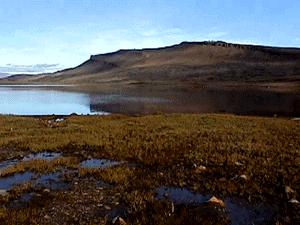
A nameless lake that the small stream pictured above feeds; the lake feeding the stream is Crescent Lake which is the water supply for Thule.
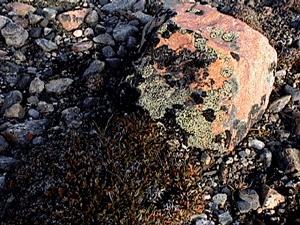
The black lichen grow only on acidic rocks.

Plants grow low to the ground like this Arctic Willow "tree" which could be 40 years old.
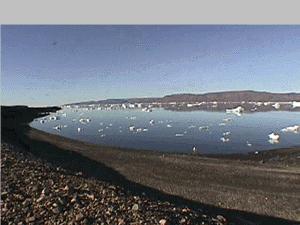
Wolfsteinholm Fjiord boarders the northern side of the Thule area peninsula. These icebergs, setting out to sea, have broken off the three glaciers in the Fjiord.
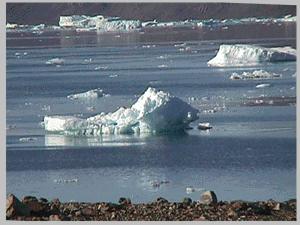
Close up of some icebergs. They melt as freshwater into the saltwater from below which sets up density currents making them very unstable. As they tumble they create a rumbling sound.
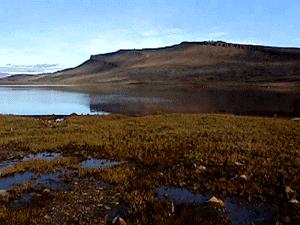
A nameless lake that the small stream pictured above feeds; the lake feeding the stream is Crescent Lake which is the water supply for Thule.
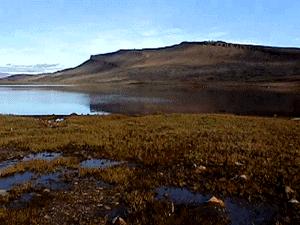
View of the lake below Crescent Lake. Notice the wetland area in front. This water comes from the melt water of the glaciers and ice cap.

Contact the TEA in the field at
.
If you cannot connect through your browser, copy the
TEA's e-mail address in the "To:" line of
your favorite e-mail package.
|
